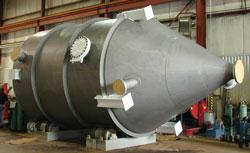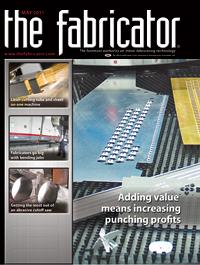- FMA
- The Fabricator
- FABTECH
- Canadian Metalworking
Categories
- Additive Manufacturing
- Aluminum Welding
- Arc Welding
- Assembly and Joining
- Automation and Robotics
- Bending and Forming
- Consumables
- Cutting and Weld Prep
- Electric Vehicles
- En Español
- Finishing
- Hydroforming
- Laser Cutting
- Laser Welding
- Machining
- Manufacturing Software
- Materials Handling
- Metals/Materials
- Oxyfuel Cutting
- Plasma Cutting
- Power Tools
- Punching and Other Holemaking
- Roll Forming
- Safety
- Sawing
- Shearing
- Shop Management
- Testing and Measuring
- Tube and Pipe Fabrication
- Tube and Pipe Production
- Waterjet Cutting
Industry Directory
Webcasts
Podcasts
FAB 40
Advertise
Subscribe
Account Login
Search
Managing people as people, not assets
Company president gets a crash course in succession planning
- August 1, 2011
- Article
- Shop Management
Elizabeth Miller made up her mind on the drive home from dinner. She was ready for a career change. Who cared that the situation was forced upon her? It was the right thing to do.
Her husband, Myles Miller, founded Miller Mechanical Services in 1988 after spending years as a boilermaker and construction superintendent in the pulp and paper industry. The business launched as a mechanical contracting firm that installed and repaired hoppers, bins, storage tanks, pressure vessels, and other large components for pulp and paper plants. His mantra: Install it right, on time.
The work required plant shutdowns that left only narrow windows of time for Miller Mechanical to get the job done. Unfortunately, the company’s installers often were left waiting for the vessels and other heavy fabrications they were hired to install, and when they finally arrived, they sometimes weren’t up to spec.
So in 1992 Miller launched a fabrication shop in Glens Falls, N.Y., that today employs 28, many of whom are skilled fabricators and welders certified to the ASME boiler code and trained in multiple arc welding processes. Such in-house talent helped the company establish an unusual niche as an installer and fabricator. If a plant needed a storage tank, hopper, or other heavy fabrication, Miller could bid not just on the installation, but also the fabrication. When it won both contracts, the company managed multiple stages of the project, including design (working closely with local pulp and paper design engineers), fabrication, and installation.
Then the unthinkable happened. Myles had heart trouble, and four years ago his heart gave out entirely. At the time Elizabeth had an 18-year-old son in the house, a 96-year-old father up the street, and a hard decision to make. She and Myles had separate working lives, so it wasn’t a given that Elizabeth would take over. She had spent more than 30 years as a language therapist and teacher working with learning-disabled children. On the surface her career couldn’t have been more unlike metal fabrication.
Moreover, succession plans were never discussed. As Elizabeth recalled, “I think Myles didn’t want to think anything would ever happen to him. So nothing formal was in place. There was no plan, so I had to make a plan quickly.”
Not long after Myles died, Elizabeth got a call from a multinational pulp and paper firm that wanted to buy the company. They took her out to dinner, discussed their plans, and made an offer. “They basically said, ‘We’ll give you X amount of money. Why don’t you hand the whole thing over?’”
On her drive home she had her revelation. “We’ve got too many valuable, talented people here, and I won’t turn my back on them.”
She felt the company was being treated like anything else bought and sold: a cold, hard asset. She didn’t blame her dinner companions. They wanted to make a deal. In their eyes, acquiring the asset would maximize shareholder value. It would be good business.
But after three decades of communicating with students, Elizabeth absorbed a lot by talking with Miller employees. They weren’t assets to be transferred from one corporate entity to another. Like her, they were people with mortgages, young children, and elderly parents.
She knew there was a good chance the multinational would absorb the parts of Miller it wanted—probably a portion of its field services—and discard the rest, including administration, accounting, and metal fabrication. “They would have kept a few of our field support staff members,” she said. “But I knew that 80 percent of the people working here probably would be gone. I knew that if I didn’t take over, there would be a lot of guys out of work.”
That’s why, during that drive home from dinner, she decided to turn down the offer.
During the weeks after Myles’ passing the company’s key managers—Bill Batkay, controller; Mick Braynan, field operations manager; Griff Thomas, shop operations manager; and Ken Loften, field operations superintendent—kept things moving. The world didn’t stop. At their principal customer’s plant, a shutdown was fast approaching, and that meant workers on the floor had to finish their fabrications so that the field service workers could install them.
“After 31 years of teaching, I understood that a lot of learning comes from listening intently,” she said. “Before I made any changes at all, I watched and I listened for about the first six months. Without those four gentlemen, I couldn’t do my job.”
Since then Elizabeth has carried on her husband’s focused, get-it-done-on-time approach. But she has left her own mark too. Elizabeth is a natural communicator, which is what initially drew her to teaching. Those skills come in handy when running a business too.
“Respect and communication: I live by those words,” she said. “You need to respect each other, and you need to communicate. Without communication, I don’t know how you get anything done.”
She has no secrets about long-term plans. At present diversification is top of mind, and this is why the company hired its first direct salesperson this year. Like many contract fabricators, Miller Mechanical has grown on the back of a few large customers, but its core competency of making and installing heavy fabrications can apply to various processing-industry applications—not just pulp and paper. Earlier this year, for instance, Miller landed its first account in the food processing business.
Diversification also was top of mind when she decided to invest in a multiaxis waterjet system capable of slicing bevels and contoured edges in various materials. The machine may cut thick copper plate one day, granite and glass the next. “The profit margin is there for this work,” Elizabeth said, “especially when we can offer the five-axis beveling. Not many can offer that capability.”
Elizabeth hasn’t forgotten what happened four years ago and knows it could happen again, which is why she has a succession plan. But the plan is mutable. Her son isn’t directly involved in the business yet, which is fine by Elizabeth. She wants him to follow his own path, which currently doesn’t involve metal fabrication. She’s keeping the door open for him but not forcing him through it. Doing so, she said, would be detrimental not only for her son but also the business.
“He isn’t passionate about the business now, but there are people here who are.” Next she said something that pretty much describes the result of any successful succession plan.
“The management team and I have worked together over the past four years. They invested in me, and I invested in them.”
subscribe now

The Fabricator is North America's leading magazine for the metal forming and fabricating industry. The magazine delivers the news, technical articles, and case histories that enable fabricators to do their jobs more efficiently. The Fabricator has served the industry since 1970.
start your free subscription- Stay connected from anywhere

Easily access valuable industry resources now with full access to the digital edition of The Fabricator.

Easily access valuable industry resources now with full access to the digital edition of The Welder.

Easily access valuable industry resources now with full access to the digital edition of The Tube and Pipe Journal.
- Podcasting
- Podcast:
- The Fabricator Podcast
- Published:
- 04/16/2024
- Running Time:
- 63:29
In this episode of The Fabricator Podcast, Caleb Chamberlain, co-founder and CEO of OSH Cut, discusses his company’s...
- Trending Articles
AI, machine learning, and the future of metal fabrication

Employee ownership: The best way to ensure engagement

Dynamic Metal blossoms with each passing year

Steel industry reacts to Nucor’s new weekly published HRC price

Metal fabrication management: A guide for new supervisors

- Industry Events
16th Annual Safety Conference
- April 30 - May 1, 2024
- Elgin,
Pipe and Tube Conference
- May 21 - 22, 2024
- Omaha, NE
World-Class Roll Forming Workshop
- June 5 - 6, 2024
- Louisville, KY
Advanced Laser Application Workshop
- June 25 - 27, 2024
- Novi, MI



























